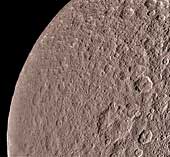|
COMETS EARTH JUPITER KUIPER BELT MARS MERCURY METEORITES NEPTUNE OORT CLOUD PLUTO SATURN SOLAR SYSTEM SPACE SUN URANUS VENUS ORDER PRINTS
PHOTO CATEGORIES SCIENCEVIEWS AMERICAN INDIAN AMPHIBIANS BIRDS BUGS FINE ART FOSSILS THE ISLANDS HISTORICAL PHOTOS MAMMALS OTHER PARKS PLANTS RELIGIOUS REPTILES SCIENCEVIEWS PRINTS
|
Related Document
Download Options
The icy, cratered surface of Saturn's moon Rhea is seen in this high-resolution image taken by Voyager l on November l1, 1980, at a range of 85,000 kilometers (52,800 miles) as the spacecraft passed over the satellite's north pole. The heavily cratered surface attests to the satellite's ancient age. The largest craters, 50 to l00 kilometers (30 to 60 miles) across and several kilometers deep, are freshly preserved in Rhea's icy crust. The craters and landscape resemble those on the Moon and Mercury, and are unlike the flattened crater forms that have collapsed in the soft icy crusts of the Jovian moons Callisto, Ganymede and Europa. Scientists believe that Rhea (which is just l,600 kilometers or 995 miles in diameter, compared to the 5,500-kilometer or 3,400- mile diameter of Ganymede) froze and became rigid, behaving like a rocky surface, very early in its history. A black and white version of this image can be found HERE. This image is Copyright © by Calvin J. Hamilton. Any commercial/for-profit use of this image needs to be addressed to Calvin J. Hamilton. |
||||||||||||||||||||||||||||||||||||
